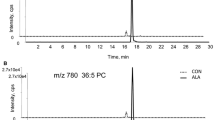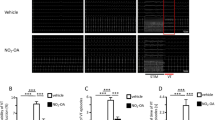Abstract
The goal of this study was to determine the mechanisms of n-3 polyunsaturated fatty acids (n-3 PUFA) on anti-arrhythmias and prevention of sudden death. The calcium-tolerant Sprague–Dawley rat ventricular myocytes were isolated by enzyme digestion. Effects of docosahexaenoic acid (DHA) and eicosapentaenoic acid (EPA) on action potentials and transient outward potassium currents (I to) of epicardial ventricular myocytes were investigated using whole-cell patch clamp techniques. Action potential durations (APDs) and I to were observed in different concentrations of DHA and EPA. APD25, APD50, and APD90 with 0.1 μmol/L DHA and EPA were prolonged less than 15% and 10%. However, APDs were prolonged in concentration-dependent manners when DHA and EPA were more than 1 μmol/L. APD25, APD50, and APD90 were 7.7 ± 2.0, 21.2 ± 3.5, and 100.1 ± 9.8 ms respectively with 10 μmol/L DHA, and 7.2 ± 2.5, 12.8 ± 4.2, and 70.5 ± 10.7 ms respectively with 10 μmol/L EPA. I to currents were gradually reduced with the increased concentrations of DHA and EPA from 1 to 100 μmol/L, and their half-inhibited concentrations were 2.3 ± 0.2 and 3.8 ± 0.6 μmol/L. The results showed APDs were prolonged and I to current densities were gradually reduced with the increased concentrations of DHA and EPA. The anti-arrhythmia mechanisms of n-3 PUFA are complex, however, the effects of n-3 PUFA on action potentials and I to may be one of the important mechanisms.





Similar content being viewed by others
Abbreviations
- PUFA:
-
Polyunsaturated fatty acids
- DHA:
-
Docosahexaenoic acid
- EPA:
-
Eicosapentaenoic acid
- I to :
-
Transient outward potassium currents
- APDs:
-
Action potential durations
- APD25 :
-
Action potential duration of 25% repolarization
- APD50 :
-
Action potential duration of 50% repolarization
- APD90 :
-
Action potential duration of 90% repolarization
- HP:
-
Holding potential
- V max :
-
Maximal velocity of action potential depolarization
- APA:
-
Action potential amplitude
- OS:
-
Overshoot
References
Lavie CJ, Milani RV, Mehra MR, Ventura HO (2009) Omega-3 polyunsaturated fatty acids and cardiovascular diseases. J Amer Coll Cardiol 54:585–594
Crumb JR, Munfakh N, Heck HA, Harrison LH (1999) Fatty acid block of the transient outward current in adult human atrium. J Pharmacol Exp Ther 289:386–391
Wilhelm M, Tobias R, Asskali F, Kraehner R, Kuly S, Klinghammer L, Boehles H, Daniel WG (2008) Red blood cell omega-3 fatty acids and the risk of ventricular arrhythmias in patients with heart failure. Amer Heart J 155:971–977
Arshad A, Mandava A, Kamath G, Musat D (2008) Sudden cardiac death and the role of medical therapy. Prog Cardiovasc Dis 50:420–438
Anand RG, Alkadri M, Lavie CJ, Milani RV (2008) The role of fish oil in arrhythmia prevention. J Cardiopulm Rehabil Prev 28:92–98
Metcalf RG, Sanders P, James MJ, Cleland LG, Young GD (2008) Effect of dietary n-3 polyunsaturated fatty acids on the inducibility of ventricular tachycardia in patients with ischemic cardiomyopathy. Amer J Cardiol 101:758–761
Von Schacky C (2008) Omega-3 fatty acids: antiarrhythmic, proarrhythmic or both? Curr Opin Clin Nutr Metab Care 11:94–99
He K (2009) Fish, long-chain omega-3 polyunsaturated fatty acids and prevention of cardiovascular disease—eat fish or take fish oil supplement? Prog Cardiovasc Dis 52:95–114
Smith CE, Freeman LM, Rush JE, Cunningham SM, Biourge V (2007) Omega-3 fatty acids in Boxer dogs with arrhythmogenic right ventricular cardiomyopathy. J Vet Intern Med 21:265–273
Leaf A (2007) Omega-3 fatty acids and prevention of arrhythmias. Curr Opin Lipidol 18:31–34
Leaf A (2006) Prevention of sudden cardiac death by n-3 polyunsaturated fatty acids. Fundam Clin Pharmacol 20:525–538
Von Schacky C, Harris WS (2007) Cardiovascular benefits of omega-3 fatty acids. Cardiovasc Res 73:310–315
Kottke TE, Wu La, Brekke LN, Brekke MJ, White RD (2006) Preventing sudden death with n-3 (omega-3) fatty acids and defibrillators. Amer J Prev Med 31:316–323
Bogdanov KY, Spurgeon HA, Vinogradova TM, Lakatta EG (1998) Modulation of the transient outward current in adult rat ventricular myocytes by polyunsaturated fatty acids. Amer J Physiol 274:H571–H579
Yang X, Salas PJ, Pham TV, Wasserlauf BJ, Smets MJ, Myerburg RJ, Gelband H, Hoffman BF, Bassett AL (2002) Cytoskeletal actin microfilaments and the transient outward potassium current in hypertrophied rat ventriculocytes. J Physiol 541:411–421
Volk T, Nguyen TH, Schultz JH, Ehmke H (1999) Relationship between transient outward K+ current and Ca2+ influx in rat cardiac myocytes of endo- and epicardial origin. J Physiol 519:841–850
Bryant SM, Shipsey SJ, Hart G (1999) Normal regional distribution of membrane current density in rat left ventricle is altered in catecholamine-induced hypertrophy. Cardiovasc Res 42:391–401
Yazawa K, Kaibara M, Ohara M, Kameyama M (1990) An improved method for isolating cardiac myocytes useful for patch-clamp studies. Jap J Physiol 40:157–163
Tytgat J (1994) How to isolate cardiac myocytes. Cardiovasc Res 28:280–283
Hamill OP, Marty A, Nether E, Sakmann B, Sigworth FJ (1981) Improved patch-clamp techniques for high-resolution current recording from cells and cell-free membrane patches. Pflugers Arch 391:85–100
Shigematsu S, Kiyosue T, Sato T, Arita M (1997) Rate-dependent prolongation of action potential duration in isolated rat ventricular myocytes. Basic Res Cardiol 92:123–128
Hulme JT, Orchard CH (2000) Effect of acidosis on transient outward potassium current in isolated rat ventricular myocytes. Amer J Physiol Heart Circ Physiol 278:50–59
Stilli D, Berni R, Bocchi L, Zaniboni M, Cacciani F, Sgoifo A, Musso E (2004) Vulnerability to ventricular arrhythmias and heterogeneity of action potential duration in normal rats. Exp Physiol 89:387–396
Fauconnier J, Bedut S, Le Guennec JY, Babuty D, Richard S (2003) Ca2+ current-mediated regulation of action potential by pacing rate in rat ventricular myocytes. Cardiovasc Res 57:670–680
Orta-Salazar G, Bouchard RA, Morales-Salgado F, Salinas-Stefanon EM (2002) Inhibition of cardiac Na+ current by primaquine. Br J Pharmacol 135:751–763
Antzelevitch C, Sicouri S, Litovsky SH, Lukas A, Krishnan SC, Di Diego JM, Gintant GA, Liu DW (1991) Heterogeneity within the ventricular wall: electrophysiology and pharmacology of epicardial, endocardial, and M cells. Circ Res 69:1427–1449
Fedida D, Braun AP, Giles WR (1993) α1-Adrenoceptors in myocardium: functional aspects and transmembrane signaling mechanisms. Physiol Rev 73:469–487
Duan D, Fermini B, Nattel S (1993) Potassium channel blocking properties of propafenone in rabbit atrial myocytes. J Pharmacol Exp Ther 264:1113–1123
Li GR, Sun HY, Zhang XH, Cheng LC, Chiu SW, Tse HF, Lau CP (2009) Omega-3 polyunsaturated fatty acids inhibit transient outward and ultra-rapid delayed rectifier K+ currents and Na+ current in human atrial myocytes. Cardiovasc Res 81:286–293
Guizy M, Arias C, David M, González T, Valenzuela C (2005) {Omega}-3 and {omega}-6 polyunsaturated fatty acids block HERG channels. Amer J Physiol Cell Physiol 289:C1251–C1260
Lai LH, Wang RX, Jiang WP, Yang XJ, Song JP, Li XR, Tao G (2009) Effects of docosahexaenoic acid on large-conductance Ca2+-activated K+ channels and voltage-dependent K+ channels in rat coronary artery smooth muscle cells. Acta Pharmacol Sin 30:314–320
Wu KT, Huang CT, Wei J, Tsait LM, Hsu CH, Chen YC, Yangs JM, Lin CI (2007) Vasodilator action of docosahexaenoic acid (DHA) in human coronary arteries in vitro. Chin J Physiol 50:164–170
**ao YF, Ke Q, Wang SY, Yang Y, Chen Y, Wang GK, Morgan JP, Cox B, Leaf A (2004) Electrophysiologic properties of lidocaine, cocaine, and n-3 fatty-acids block of cardiac Na+ channels. Eur J Pharmacol 485:31–41
Arnold C, Konkel A, Fischer R, Schunck WH (2010) Cytochrome P450-dependent metabolism of omega-6 and omega-3 long-chain polyunsaturated fatty acids. Pharmacol Rep 62:536–547
Pottala JV, Garg S, Cohen BE, Whooley MA, Harris WS (2010) Blood eicosapentaenoic and docosahexaenoic acids predict all-cause mortality in patients with stable coronary heart disease: the Heart and Soul study. Circ Cardiovasc Qual Outcomes 3:406–412
Galli C, Risé P (2009) Fish consumption, omega 3 fatty acids and cardiovascular disease. The science and the clinical trials. Nutr Health 20:11–20
He JY, Kargacin ME, Kargacin GJ, Ward CA (2003) Tamoxifen inhibits Na+ and K+ currents in rat ventricular myocytes. Amer J Physiol Heart Circ Physiol 285:661–668
Adamantidis MM (1995) Mechanisms of action of class III antiarrhythmia agents. Arch Des Maladies du Coeur et des Vaisseaux 88:33–40
**ao YF, Sigg DC, Ujhelyi MR, Wilhelm JJ, Richardson ES, Iaizzo PA (2008) Pericardial delivery of omega-3 fatty acid: a novel approach to reducing myocardial infarct sizes and arrhythmias. Amer J Physiol Heart Circ Physiol 294:H1144–H1152
Den Ruijter HM, Berecki G, Verkerk AO, Bakker D, Baartscheer A, Schumacher CA, Belterman CN, de Jonge N, Fiolet JW, Brouwer IA, Coronel R (2008) Acute administration of fish oil inhibits triggered activity in isolated myocytes from rabbits and patients with heart failure. Circulation 117:536–544
Reiner E, Tedeschi-Reiner E, Stajminger G (2007) The role of omega-3 fatty acids from fish in prevention of cardiovascular diseases. Lijec Vjesn 129:350–355
Jacobson TA (2007) Beyond lipids: the role of omega-3 fatty acids from fish oil in the prevention of coronary heart disease. Curr Atheroscler Rep 9:145–153
Farzaneh-Far R, Lin J, Epel ES, Harris WS, Blackburn EH, Whooley MA (2010) Association of marine omega-3 fatty acid levels with telomeric aging in patients with coronary heart disease. JAMA 303:250–257
Acknowledgments
This work was supported, in part, by a grant (CS20010015) from the Wuxi Science and Technology Bureau of Jiangsu Province, China; and by the Specialized Research Fund for the ‘135’ Project (RC2007001) from Jiangsu Province of China. The authors thank Miss Lian-hua Han for her assistance in the preparation of this paper.
Author information
Authors and Affiliations
Corresponding author
About this article
Cite this article
Li, HX., Wang, RX., Li, XR. et al. Increasing DHA and EPA Concentrations Prolong Action Potential Durations and Reduce Transient Outward Potassium Currents in Rat Ventricular Myocytes. Lipids 46, 163–170 (2011). https://doi.org/10.1007/s11745-010-3503-3
Received:
Accepted:
Published:
Issue Date:
DOI: https://doi.org/10.1007/s11745-010-3503-3




